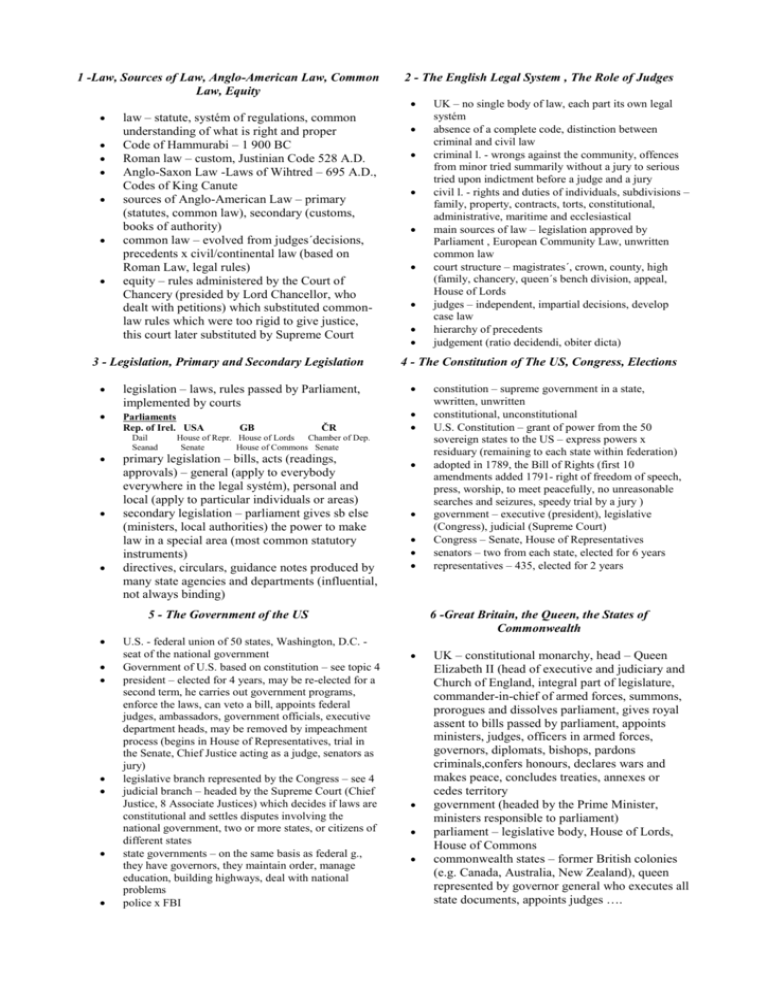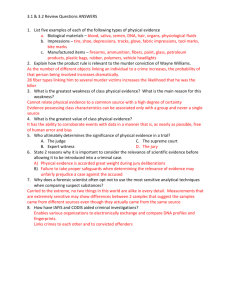1 -Law, Sources of Law, Anglo-American Law, Common Law, Equity
advertisement

1 -Law, Sources of Law, Anglo-American Law, Common Law, Equity law – statute, systém of regulations, common understanding of what is right and proper Code of Hammurabi – 1 900 BC Roman law – custom, Justinian Code 528 A.D. Anglo-Saxon Law -Laws of Wihtred – 695 A.D., Codes of King Canute sources of Anglo-American Law – primary (statutes, common law), secondary (customs, books of authority) common law – evolved from judges´decisions, precedents x civil/continental law (based on Roman Law, legal rules) equity – rules administered by the Court of Chancery (presided by Lord Chancellor, who dealt with petitions) which substituted commonlaw rules which were too rigid to give justice, this court later substituted by Supreme Court 3 - Legislation, Primary and Secondary Legislation legislation – laws, rules passed by Parliament, implemented by courts Parliaments Rep. of Irel. USA Dail Seanad GB ČR 2 - The English Legal System , The Role of Judges 4 - The Constitution of The US, Congress, Elections House of Repr. House of Lords Chamber of Dep. Senate House of Commons Senate primary legislation – bills, acts (readings, approvals) – general (apply to everybody everywhere in the legal systém), personal and local (apply to particular individuals or areas) secondary legislation – parliament gives sb else (ministers, local authorities) the power to make law in a special area (most common statutory instruments) directives, circulars, guidance notes produced by many state agencies and departments (influential, not always binding) 5 - The Government of the US U.S. - federal union of 50 states, Washington, D.C. seat of the national government Government of U.S. based on constitution – see topic 4 president – elected for 4 years, may be re-elected for a second term, he carries out government programs, enforce the laws, can veto a bill, appoints federal judges, ambassadors, government officials, executive department heads, may be removed by impeachment process (begins in House of Representatives, trial in the Senate, Chief Justice acting as a judge, senators as jury) legislative branch represented by the Congress – see 4 judicial branch – headed by the Supreme Court (Chief Justice, 8 Associate Justices) which decides if laws are constitutional and settles disputes involving the national government, two or more states, or citizens of different states state governments – on the same basis as federal g., they have governors, they maintain order, manage education, building highways, deal with national problems police x FBI UK – no single body of law, each part its own legal systém absence of a complete code, distinction between criminal and civil law criminal l. - wrongs against the community, offences from minor tried summarily without a jury to serious tried upon indictment before a judge and a jury civil l. - rights and duties of individuals, subdivisions – family, property, contracts, torts, constitutional, administrative, maritime and ecclesiastical main sources of law – legislation approved by Parliament , European Community Law, unwritten common law court structure – magistrates´, crown, county, high (family, chancery, queen´s bench division, appeal, House of Lords judges – independent, impartial decisions, develop case law hierarchy of precedents judgement (ratio decidendi, obiter dicta) constitution – supreme government in a state, wwritten, unwritten constitutional, unconstitutional U.S. Constitution – grant of power from the 50 sovereign states to the US – express powers x residuary (remaining to each state within federation) adopted in 1789, the Bill of Rights (first 10 amendments added 1791- right of freedom of speech, press, worship, to meet peacefully, no unreasonable searches and seizures, speedy trial by a jury ) government – executive (president), legislative (Congress), judicial (Supreme Court) Congress – Senate, House of Representatives senators – two from each state, elected for 6 years representatives – 435, elected for 2 years 6 -Great Britain, the Queen, the States of Commonwealth UK – constitutional monarchy, head – Queen Elizabeth II (head of executive and judiciary and Church of England, integral part of legislature, commander-in-chief of armed forces, summons, prorogues and dissolves parliament, gives royal assent to bills passed by parliament, appoints ministers, judges, officers in armed forces, governors, diplomats, bishops, pardons criminals,confers honours, declares wars and makes peace, concludes treaties, annexes or cedes territory government (headed by the Prime Minister, ministers responsible to parliament) parliament – legislative body, House of Lords, House of Commons commonwealth states – former British colonies (e.g. Canada, Australia, New Zealand), queen represented by governor general who executes all state documents, appoints judges …. 7 - British Parliament supreme legislative body, functions 3 elements – queen (summons, proroques.., gives speeches in parliament, gives royal assent), House of Lords (Lords Spiritual - archbishop, bishops, and Temporal – hereditary peers, life peers, lords of appeal) , House of Commons (elected, 650 Mps, when an MP dies, by-elections také place, presided by Speaker) UK divided into constituencies, each of which returns one member of the House of Commons, elections by secret ballot, voters – over 18, resident in UK, registered in the annual voting register, not subject to any disqualification 9 - Criminal and Civil Law criminal l. - regulates relationships between the state and individuals, omissions and acts contrary to public order, punishment – fine, imprisonment...., crimes – murder, rape, robbery, burglary, forgery, smuggling..., criminal liability criminal proceeding – prosecutor, defendant, magistrates´and crown court, prove beyond reasonable doubt, jury finds guilty or innocent, judge decides the punishment civil l. - regulates relationships between individuals and bodies, no punishment, but awarding remedies (damages, specific performance), kinds – contract, torts, family, property, civil liability civil proceeding – plaintiff, defendant, petitioner, respondent, county court, hight court, prove on the balance of probabilities 8 - Company Law sole proprietorship -1 owner partnership-pooling of capital business corporations – shareholders, directors, officers, board of directors insolvency – inability to pay debts bankruptcy – sale of assets, surplus returned to the debtor trustee in bankruptcy appointed by the creditors or Secretary of State or the court liquidation – winding up – life of the company is brought to an end, the property is administered for the benefit of its members and creditors, voluntary, involuntary striking off the register certificate of incorporation, articles of incorporation memorandum of a company/společ.zaklsml – name, situation of office, objects of company, liability of members, share capital, articles of association/bylaws – general meetings, appointment of directors, shar capital, dividends, profits 10 - Substantive and Procedural Law substantive l. - purports to regulate specified areas (contract, tort, property..), creates, defines and regulates rights and duties of parties, substantive criminal law – declares what conduct is criminal and prescribes the punishment – codified in criminal, penal codes procedural l. - only lays down the framework within which the substantive l. can operate, prescribes method of enforcing the rights or obtaining redress for their invasion, criminal procedure – investigation, prosecution, adjudication, punishment … 12 – Torts 11 - Public and Private Law public – distribution and exercise of power by the state and relations between the state and the individual, it may be general (applying to all people within the jurisdiction), local (to a geographical area), special (to an organization which is charged with a public interest). The aim of public l. - protection of collective interests private – relationships between individuals (employer-employee, consumer´s rights). The aim – protection of individual interests. 13 - tort – civil wrong function – to compensate a plaintiff elements common to all torts – existence of a duty owed to the plaintiff by the defendant, violation of the duty, proving that the violation was the cause of the injuries, damages damage (loss, injury) x damages (compensation) general defences in tort – inevitable accident, voluntary assumption of risk, self-defence, consent, statutory authority immunity from liability – members of government, minors, family relationship private x public nuisance negligence trespass to person – assault, battery, false imprisonment, defamation trespass to land 14 - Labour Law 16 – Criminal Trial 15 - Family Law family – basic social unit – husnad, wife, unit adoption x guardianship/custodianship (opatrovnictví) voidable marriage (zrušitelné) – may be nullified (fraud, impotency, force, lack of mental capacity) void m. - no legal effect legitimate x illegitimate child (conceived in wedlock?) community property x separate p. (gift, inheritance, acquired before marriage) common law marriage (společná domácnost) employment – relationship between an employer and an employee employee performs services or does work under the direction of the employer collective bargaining – carried out by trade unions on behalf of the employees – rights and obligations of both of them contract of employment – parties, start of employment, wage/salary, conditions of work, holiday, sickness payment, pensions, period of notice duties of employees – render personal service, také care, obey instructions, give loyal service reasons for discharging an employee – disobedience, disloyalty, theft, intoxication, incompetency financial support provided by the security systém – death benefit, old-age benefit, maternity, sickness benefit, family allowance... defendant must be presumed innocent, can employ a legal adviser, be informed of evidence or witnesses, can hear them or call his own witnesses, can stand mute, is judged by judge (determines the questions of law) and jury (guilt), can´t be tried twice for the same offence, can appeal offences – triable on indictment, triable summarily, triable either way evidence – witnesses, documentary evidence, real evidence (exhibits), inspection of the place or object sentences – imprisonment, community order, probation (podmínka), fine … 17 - Commercial Law, Contracts, Corporations intellectual property – trademark, design, copyright, patent, breeder´s rights, passing off – imitating goods, selling them under the same name contract – agreement between 2 or more people to exchange st of value employment, lease, sales contract elements of a contract – agreement, competenct parties, genuine assent, consideration, lawful objective, in the form required by law- written, oral... bilateral (2 promises) x unilateral (promise, act) valid, void, voidable contract unenforceable c. - oral sale of real property executed x executory c. Sole proprietorship partnership corporation – shareholders, board of directors, officers articles of incorporation and association 18 - International Law, EC Law 19 - Education systém compulsory education (GB 5-16, CR 6-15) creches, kindergarten, primary/basic school, secondary/high school, college, university (Bachelor, Master of Science, of Arts, PhD) 16 – GCSE, 18 – A-levels, CR – school-leaving examination, entrance exams subjects – Czech, languages, maths, physics, chemistry, biology, geography, PE, games types of schools – technical, vocational, gymnasium, philosophical, theological, pedagogical, medical, law faculties Charles University (founded 1348), Cambridge, Birmingham, Hull, Harvard, Chicago, San Francisco... our school international law - public (rights and duties of states towards each other), private – rights and duties of private individuals of different states) national, municipal law – internal legal rules of a state sources of inter. Law – treaties, customs European Communities – European Economic C., European Coal and Steel C., Euratom Institutions of the EU – Council of Ministers (of EU), Assembly (Parliament), Court of Justice EC law – regulations (nařízení) – directly applicable in every member state, directives (směrnice) – binding as to the result, the form left on the member states, decisions (rozhodnutí) – addressed to states, individuals or companies, binding only on them 20 - European Union 1993 – Treaty on EU/Maastricht Treaty main objectives – economic and social progress, common foreign and security policy, common defence institutions – E. Parliament (direct elections, 5 years term, legislative process, designate an Ombudsman, discuss the annual General Report submitted by the Commission, approve the Commission, participate in the budgetary procedure...), Council (decision making body, composed of ministers...), Commission (27 members, proposes legislation to Parliament and Council, participate in the legislation, negotiate international agreements, represent the community, publish an annual report on the activities of the community, formulate recommendations and deliver opinions), Court of Justice (judges, advocates-general, 6 years, settle disputes), Court of Auditors (examines financial accounts and operations of the EC)







